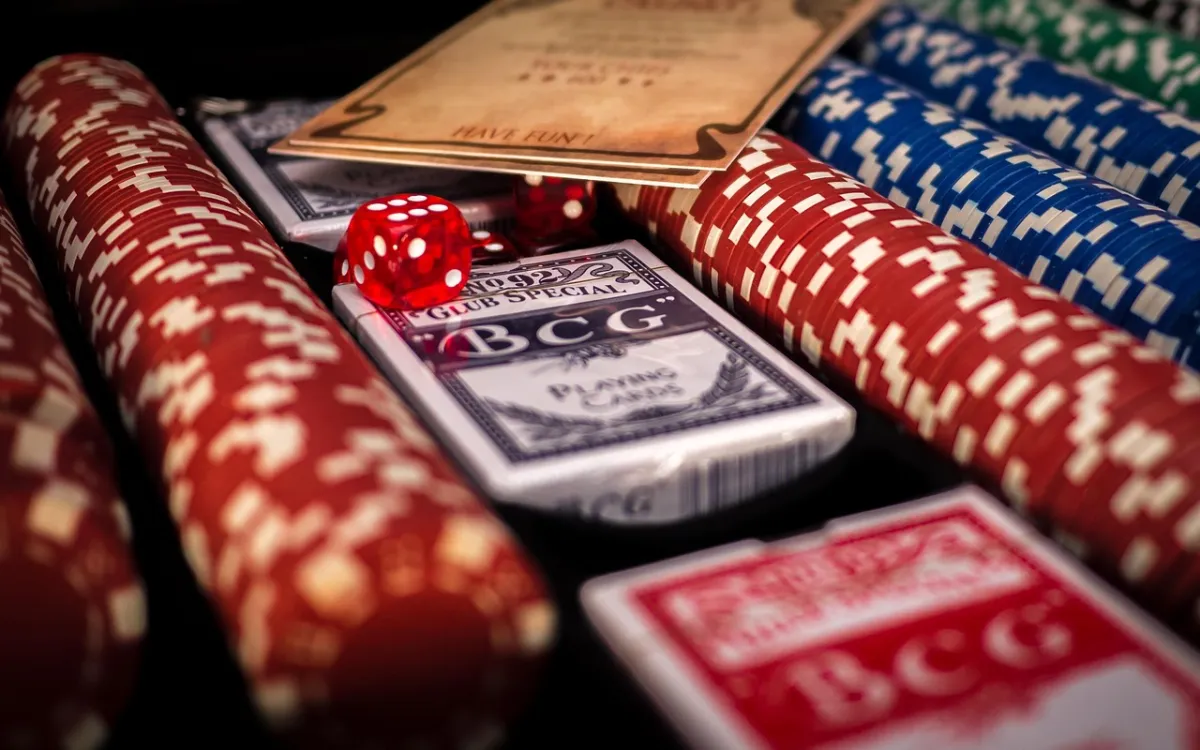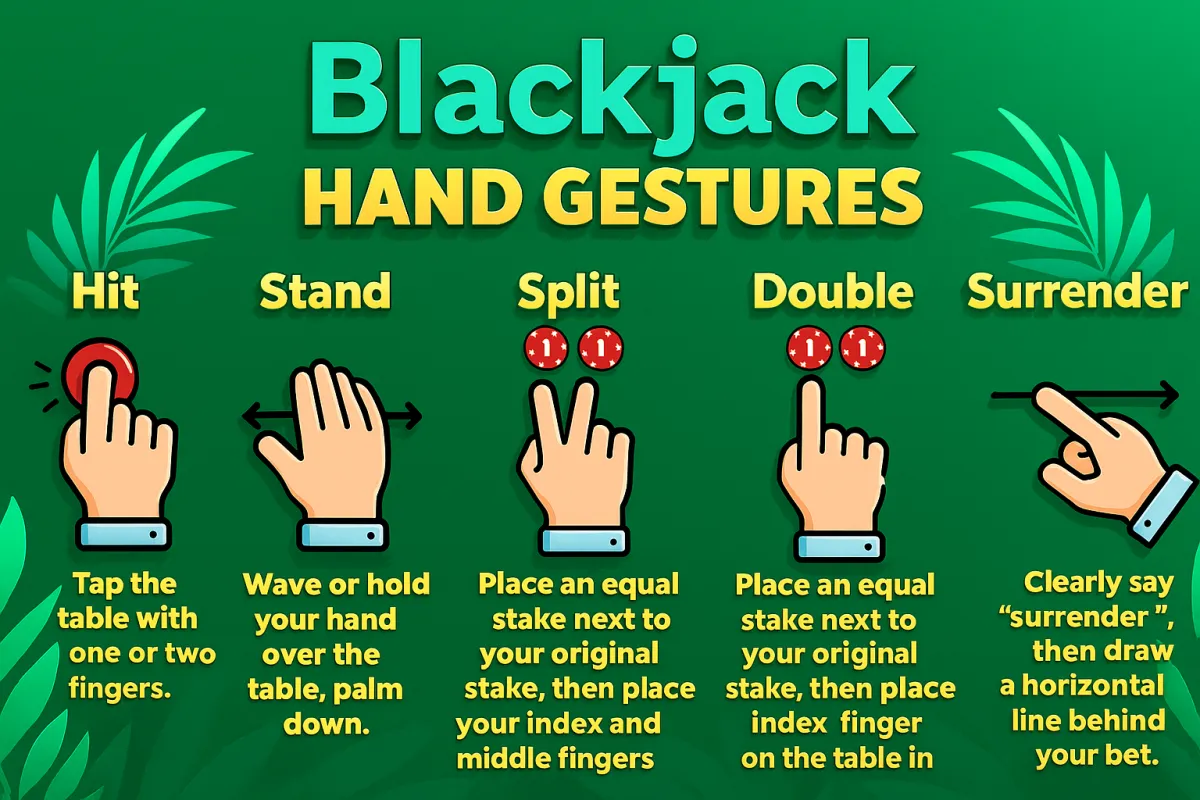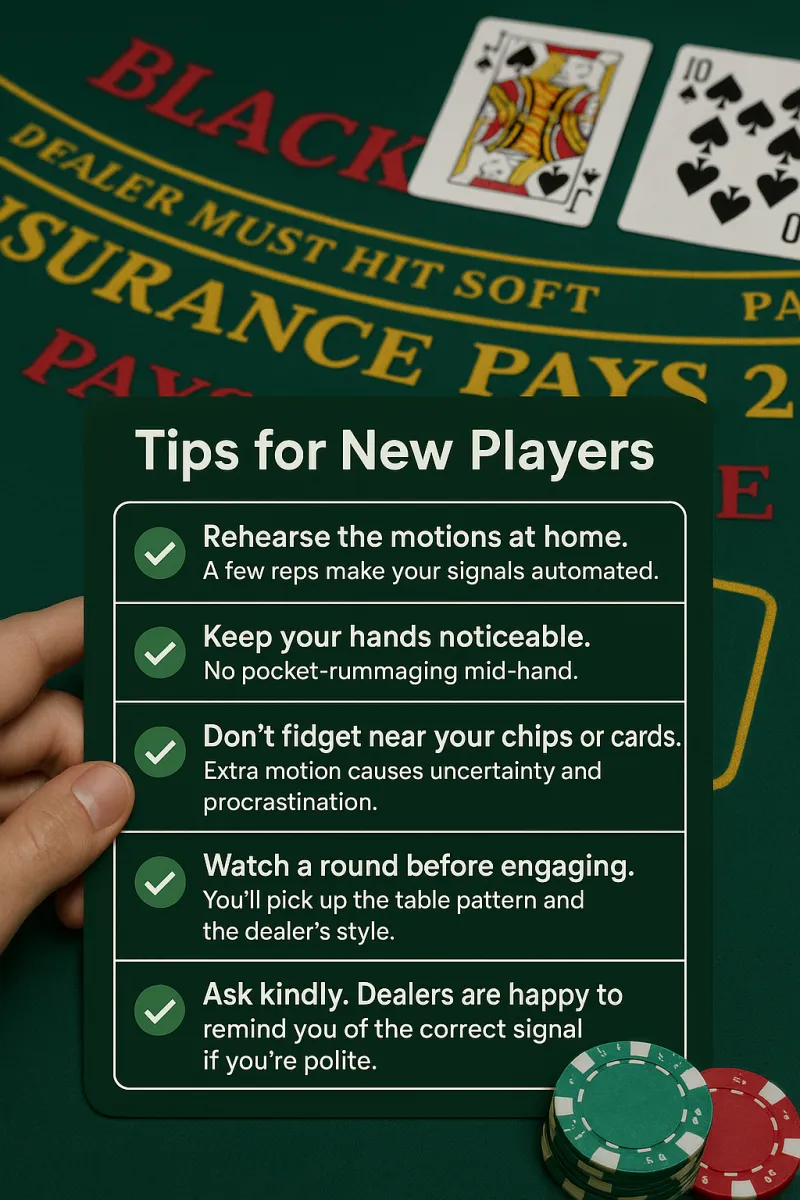Blackjack Hand Signals: Complete Guide to Table Etiquette & Winning Communication

Misinterpreting a signal can lead to an extra card you never wanted, a bet you didn’t mean to place, or a decision that goes against you. This guide knocks down the official hand signal, table etiquette, differences by region and game type, and useful guidance so you can play confidently from your very first session.
Why Blackjack Hand Gestures Matter
- Casinos rely on optical proof. Your hand movement creates a clear, verifiable record of your choices. Supervision (the “eye in the sky”) and pit bosses can review footage if anything seems off.
- They prevent disputes. If you said “stand” softly but made a hit motion, the cameras will pick up the signal. Signals are the playoffs because they’re visible to everyone.
- They’re part of the rules. In physical casinos, signals aren’t voluntary; they’re the expected way to converse with the dealer.
- Online vs. in-person. Online blackjack uses virtual buttons instead of gestures. In live casinos, your hands are your buttons.

Getting to Know the Blackjack Table
Before you can master gestures, it helps to understand what’s happening on the table in front of you. A blackjack table has a simple setup once you know what everything means.
The Table Layout
The table is shaped like a semicircle. The dealer stands on the straight side, and the participants sit around the curved edge. Each player has their own Gambling house (a small circle or box on the felt) where they place their chips before the cards are dealt.
Here’s what else you’ll notice on the table:
- Card Shoe: A plastic box that holds various decks of cards. It’s where the dealer draws cards from during play.
- Scrap Tray: Used cards are placed here face-up after each round.
- Chips Rack: This is where the dealer keeps the casino’s chips for payment and collections.
- Guidelines: Many tables have the main rules printed right on the felt, like “Dealer must draw to 16 and stand on all 17s.”
Where to Place Your Chips and Cards: When it’s time to play, put your bet smartly inside your betting circle before the first card is dealt. Once the game starts, don’t touch your chips unless you’re making a shift that requires it (like doubling down or splitting).
How you maintain the cards depends on the type of game:
- Face-Up (Shoe) Games: The dealer deals your cards face-up on the table. You never touch the cards; all your moves are done with gestures.
- Face-Down (Handheld) Games: You’ll receive your cards face down and can hold them with one hand only. Any signal you make should use the cards themselves, like lightly scratching them on the felt to indicate a hit.
Understanding Player Station
If you hear people mention “first base” or “third base,” don’t worry; it’s not baseball talk!
- First Base: The seat to the dealer’s far left. This player acts first every round.
- Third Base: The seat to the dealer’s far right. This player acts last, right before the trader plays their own hand.
Your seat doesn’t change the rules, but it can affect recognition. If you’re at third base, make your hand signals extra clear so the dealer and cameras can see them easily.
Shoe Games vs. Handheld Games
You’ll usually find shoe games in bigger casinos. They use several decks, run faster, and rely heavily on clear hand signals because players don’t touch the cards.
Handheld consoles, often found in smaller or local casinos, use fewer decks. Players hold their cards and use smaller, more subtle movements to communicate. The key difference is this:
- Shoe game = hands off the cards
- Handheld game = one hand on the cards
Blackjack Hand Signals Explained (Main Actions)
In blackjack, your hand signals tell the dealer what you want to do, whether you’d like another card, want to stay where you are, or plan to double or divide your hand. These signals can vary depending on the type of game you’re playing.
- In open-face games, you don’t touch the cards; you use your hands to indicate directly on the table.
- In hidden-card games, you’re allowed to handle your cards, and the gestures involve the cards themselves.
Here’s how each action works in plain terms.
Hit
When you want another card, that’s called a “hit.”In an open-face game, you simply tap the table gently with one finger right behind your cards. It’s like knocking carefully on the table to say, “I’ll take one more, please.”
In a hidden-card game, you hold your cards and gently scratch them toward yourself on the felt. This tells the dealer you’d like another card.
Try to make your move clear and easy to see. Don’t wave your hand in the air, which can look like you’re saying “stand” rather than “hit.” Once the dealer sees your sign, they’ll deal one card face-up to your hand so everyone can see it.
Stand
If you’re content with your total and don’t want any more cards, you’ll “stand.” The signal is easy: wave your hand flat over your cards with your palm facing down. It’s like brushing the air gradually above your cards to say, “I’m good.” In hidden-card games, you don’t need to wave; you can just insert your cards under your bet without touching your chips. That tells the dealer your hand is finished.
Whatever category you use, make sure it’s easy and assured. A tiny flick or semi-motion might confuse the dealer or look unclear on camera.
Double Down
Doubling down means you’re feeling positive about your hand and want to double your initial bet in exchange for just one more card. To do it, place an amount of chips equivalent to your first bet next to it.
While you do this, hold up one finger to show you only want one card. Most participants also say “Double” at the same time, so there’s no uncertainty.
Once you’ve doubled, you’ll get just one more card, and that’s last. You can’t hit again afterward. The dealer will deal your next card face-up and then move on to the next player.
Split
When your first two cards are the same figure, like two 8s or two Queens, you can “divide” them into two separate hands. To indicate a split, put down another bet equal to your first one right next to it. If you’re playing face-up, you can also make a “peace sign” with two fingers to show that you have separated the pair. In hidden-card games, you can lightly move the two cards apart a bit to show your intention.
The dealer will split your cards, give each one a new card, and you’ll now play each hand one at a time. Keep in mind that some casinos have unique rules, especially when it comes to separating Aces.
Most will only let you draw one card per Ace and don’t allow re-splits.
Surrender
Sometimes, the best step is to fold your hand early and save half your bet; that’s what “surrender” means. To do this, draw a small unreal line across the felt behind your betting circle with your finger. This sign tells the dealer you’re surrendering your hand. In some casinos, you can just say “Surrender” rather than, especially if the gesture isn’t widely used there. It’s significant to know that not every casino offers this option, so check before you start playing. Participants usually surrender when the dealer’s up-card is very strong, like a 9, 10, or Ace, and their own hand isn’t looking good.
Face-Up vs. Hidden-Card Games: How Signals Differ
Dealing styles
- Shoe (face-up): You never touch the cards. All gestures happen on the felt.
- Handheld (face-down): You hold the cards (with one hand) and use small movements with the cards themselves.
Quick contrast
| Action | Face-Up (Shoe) – Player Doesn’t Touch Cards | Face-Down (Handheld) – Player Holds Cards |
|---|---|---|
| Hit | Tap the felt behind your cards | Gently scratch the cards toward yourself |
| Stand | Wave palm down horizontally over the cards | Insert/slide cards under your bet (don’t touch chips) |
| Double Down | Add equal chips next to the bet; show one finger | Add equal chips; place cards face down to signal done |
| Split | Add identical chips; show two fingers/peace sign | Add the same chips; carefully split the pair |
| Surrender | Draw a horizontal line after the bet (or say it) | Same signal or verbal “Surrender,” if allowed |
Regional inclination: U.S. casinos ordinarily run shoe games; small rooms and certain zonal venues may feature handheld games. Europe and Macau are mainly shoe-game territories, though customs can vary by property.
Usual Hand Signal Error (and How to Avoid Them)
- Uncertain gestures: If you tap too gently or wave roughly, the dealer may not act—or worse, misinterpret it. Fix: Make every movement intentional and near your cards.
- Touching chips mid-hand: Changing your stack after the deal can look like tampering. Fix: Hands off the wager unless doubling or dividing.
- Mixed communication: Saying “hit” while waving a hand motion confuses everyone. Fix: If you speak, match your words to your signal.
- Changing your mind after signaling: In almost all casinos, your first clear gesture stands. Fix: Take a breath, conclude, then signal.
Blackjack Table Etiquette: Beyond the Hand Signals
When you join a blackjack table, wait until the present hand is finished, then place your cash on the felt and ask the dealer to trade it for chips; never hand it instantly. If you’re in a face-up game, don’t touch the cards; in hidden card games, hold them with one hand and keep them above the table. Always keep your hands noticeable so the dealer and cameras can see everything clearly. Respect the speed of play by being ready when it’s your turn and avoiding extra delays. Never touch another player’s chips or cards, as it’s considered bad etiquette and can cause uncertainty. Finally, tipping the dealer after a good hand or kind service is a nice gesture that keeps the table atmosphere helpful and regarded.
Regional & Casino Difference
- Las Vegas: Extremely shoe-game focused; standard U.S. signals apply. Surrender accessibility varies by property and table.
- Atlantic City: Similar to Vegas, with familiar shoe games and clear hand-signal standards. Some tables limit mid-shoe entry or vary on surrender.
- Macau: Predominantly shoe games; gestures closely mirror U.S. style. Verbal calls are usual, but signals still rule.
- Europe/UK: Mostly shoe games; signals are generally the same. Some houses emphasize verbal verification alongside gestures.
Bottom line: House rules can tweak what’s acceptable. Glance at the table placard and ask the dealer if you’re uncertain.
Dealer Signals and Reply
Just like players, dealers use clear hand signals to keep the game clear and steady. These motions help cameras and pit bosses verify every measure, ensuring fair play for everyone at the table.
| Dealer Signal | Meaning / Action | Explanation |
|---|---|---|
| Hit (Dealing a Card) | Dealer taps the table and deals one card face-up. | Verify that the player requested another card. |
| Stand (Player Done) | Dealer nods or says “No more?” before proceeding to the next player. | Recognize the player’s stand signal. |
| Bust | The dealer declares “Too many” and sweeps the cards to the discard tray. | Specify that the player went over 21 and loses the bet. |
| Blackjack | The dealer shows their Ace and 10-value card with both hands. | Notify a natural blackjack for either side. |
| Insurance Offer | The dealer signals a hand over the arrangement and says, “Insurance open.” | Let's players place insurance bets when the dealer shows an Ace. |
| Insurance Closed | Dealer signals again and says, “Insurance closed.” | Signals that no more insurance bets can be made. |
| Payout | The dealer places winning chips beside the player’s bet. | Shows the payment clearly before pushing the chips forward. |
| Collect / Take Bet | The dealer sweeps losing bets toward their chip rack. | Makes losses noticeable and verifies the result. |
Tips for New Players

Online and Live Dealer Blackjack: Modern Adjustment
In online blackjack, buttons replace hand signals; you directly click to hit, stand, double, or split, and the software records your choice immediately. Live dealer blackjack keeps the real casino feel, with dealers using traditional signals while players make moves virtually. This setup blends easily with validity, keeping the game fair and visually clear for everyone.
Conclusion: Mastering Blackjack Communication
Clear hand gestures make you look self-assured, keep the game moving, and safeguard both you and the casino. In a dispute, cameras trust what they see: your gesture. Learn the motions for hit, stand, double, split, and surrender; keep your hands noticeable; and follow basic etiquette. It’s a small effort that pays off in stable sessions and fewer headaches. Before you play, check the table’s house rules and, when uncertain, ask the dealer, then signal like a pro.